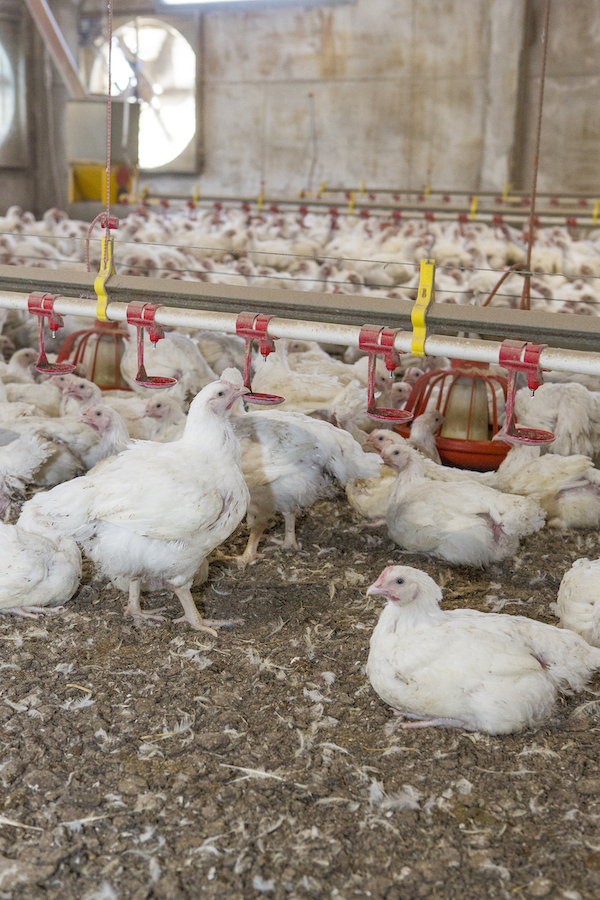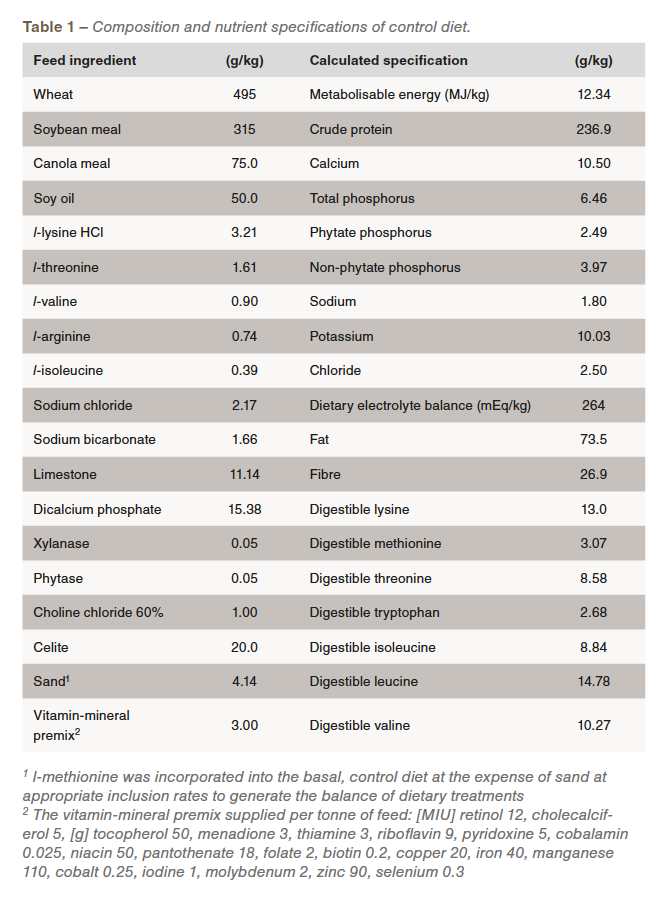
The objective of this study was to evaluate the impact of methionine supplementation on amino acid concentration in systemic plasma, apparent amino acid digestibilities and their relevance to growth performance in broiler chickens from 0-21 days post-hatch.
S.Y. Liu1, P.V. Chrystal1, Y. Kim2, Y.M. Bao3, P.H. Selle1
1 Poultry Research Foundation, Camden NSW 2570; 2 CJ Bio, Korea; 3 Redox Pty Ltd, Minto NSW 2566
Four experimental diets based on wheat, soybean meal and canola meal were supplemented with 0, 1.38, 2.76 and 4.14 g/kg l-methionine which reflected total sulphur amino acid (TSAA) to lysine (Lys) ratios of 50, 60, 70 and 80, respectively. Each of the four treatments was offered to 6 replicates with 8 birds per replicate or total 192 off-sex male Ross 308 chicks (parent line). There was quadratic correlation between TSAA:Lys ratios and growth performance (P<0.05). At day 20, increasing dietary TSAA:Lys ratios linearly increased systemic plasma concentrations of Met (r=0.841, P<0.001) but decreased concentrations of His, Ser, Gly, Thr, Lys and Val (P<0.05). In contrast, increasing dietary TSAA:Lys ratios from 50 to 70 and 80 increased apparent digestibility coefficients of 16 analysed amino acids (P<0.001). The present study emphasised the importance of amino acid balance on protein utilisation and deposition; additionally it suggested the additional value of increasing dietary TSAA:Lys ratios from 70 to 80.
Introduction
Methionine (Met) is often considered to be the first limiting amino acid in modern broiler diets. Synthetic Met has been commercially available for animal feed since the 1950s and is routinely included in modern poultry diets. Whilst studies on Met requirements, based on growth performance parameters are not novel, understanding the impact of dietary Met supplementations on apparent digestibility and plasma concentrations of amino acid is important in conventional diets but particularly in reduced crude protein diets. A preliminary study by Truong et al. (2017) reported that synthetic amino acid inclusions altered free amino acid concentrations individually and collectively in both portal and systemic blood plasma despite there being no correlation between growth performance and plasma amino acid concentrations. The present study continued the investigation, examining the impact of Met supplementation on amino acid concentration in systemic plasma, apparent amino acid digestibilities and their relevance to growth performance in broiler chickens.
Materials and methods
The feeding study complied with specific guidelines approved by the Animal Ethics Committee of The University of Sydney. Four experimental diets based on wheat, soybean meal and canola meal were supplemented with 0, 1.38, 2.76 and 4.14 g/kg l-methionine which reflected total sulphur amino acid (TSAA) to lysine (Lys) ratios of 50, 60, 70 and 80, respectively. Each of the four treatments were offered to 6 replicates with 8 birds per replicate or total 192 off-sex male Ross 308 chicks (parent line) from 0-21 days post-hatch. The four experimental diets were formulated to be iso-energetic (12.34 MJ/kg) and contained the same dietary levels of digestible lysine (13.0 g/kg) as shown in Table 1. All diets contained commercially relevant inclusions of phytase and xylanase and diets were steam-pelleted at 80 °C then crumbled. Diets were initially offered to birds as crumble from 0-14 days and subsequently in pellet form. Chickens had ad libitum access to feed and water. Initial and final body weights were determined, and feed intakes were recorded to calculate feed conversion ratios (FCR). The incidence of dead or culled birds was recorded daily and their body-weights used to adjust FCR calculations. During 18 to 20 days post-hatch, feed intake and excreta output were recorded to determine apparent metabolizable energy (AME), N corrected apparent metabolizable energy (AMEn) and N retention. At day 20, three birds at random were selected from each cage and blood samples were taken from the brachial vein. Blood samples were then centrifuged and the decanted plasma samples were stored at -80 °C prior to analysis. Concentrations of twenty proteinogenic amino acids in plasma were determined using precolumn derivatisation amino acid analysis with 6-aminoquinolyl-N-hydroxysuccinimidyl carbamate (AQC; Waters™ AccQTag Ultra; www.waters.com) followed by separation of the derivatives and quantification by reversed phase ultra-performance liquid chromatography (Cohen, 2001). At day 21, all birds were euthanized and digesta samples were collected from the distal ileum and pooled from the same cage to determine the apparent digestibility of protein and amino acids. ANOVA and linear and quadratic correlations were performed using JMP® 13.0.0 and significance was determined at P<0.05 by Student’s t-test.
Results and discussion
The effects of dietary treatments on growth performance and nutrient utilisation are shown in Table 2.
 Increasing TSAA:Lys ratios from 50 to 60 significantly improved weight gain, FCR and N retention. There was quadratic correlation between TSAA:Lys ratios and growth performance (Figure 1). Based on the regression equation, the optimal weight gain of 1036 g/bird was predicted when TSAA:Lys ratio equalled 74.9 whereas the optimal FCR of 1.198 was predicted to be reached when TSAA: Lys ratio equalled 74.2. Various targeted parameters may lead to different amino acid requirements; for instance, Liu et al. (2019) reported digestible lysine requirement for FCR was higher than that for weight gain (12.3 versus 11.3 g/kg). Figure 2 illustrates the influence of TSAA:Lys ratios on apparent digestibilities of amino acids in the distal ileum. Supplementation of Met linearly increased apparent digestibility of Met. Dietary TSAA:Lys ratios significantly influenced apparent digestibility of all amino acids and increasing TSAA:Lys ratios from 50 to 80 significantly increased apparent digestibility of Gly, Pro, Val, Ile, Leu and Phe.
Increasing TSAA:Lys ratios from 50 to 60 significantly improved weight gain, FCR and N retention. There was quadratic correlation between TSAA:Lys ratios and growth performance (Figure 1). Based on the regression equation, the optimal weight gain of 1036 g/bird was predicted when TSAA:Lys ratio equalled 74.9 whereas the optimal FCR of 1.198 was predicted to be reached when TSAA: Lys ratio equalled 74.2. Various targeted parameters may lead to different amino acid requirements; for instance, Liu et al. (2019) reported digestible lysine requirement for FCR was higher than that for weight gain (12.3 versus 11.3 g/kg). Figure 2 illustrates the influence of TSAA:Lys ratios on apparent digestibilities of amino acids in the distal ileum. Supplementation of Met linearly increased apparent digestibility of Met. Dietary TSAA:Lys ratios significantly influenced apparent digestibility of all amino acids and increasing TSAA:Lys ratios from 50 to 80 significantly increased apparent digestibility of Gly, Pro, Val, Ile, Leu and Phe.


 The significant improvement in apparent digestibility of amino acids and the overall N retention emphasized the importance of dietary amino acid balance. Moreover, increasing TSAA:Lys ratios linearly decreased systemic plasma concentrations of His, Ser, Gly, Thr, Lys and Val but linearly increased systemic plasma concentrations of Met (P<0.05, Figure 3). Interestingly, weight gain was negatively correlated with plasma concentrations of His (r=-0.532, P=0.008), Ser (r=-0.514, P=0.010), Thr (r=-0.528, P=0.008), Lys (r=-0.623, P=0.001) and positively correlated with Met concentration (r=0.427, P=0.038). Similarly, FCR was correlated with His (r=0.728, P<0.001), Ser (r=0.629, P=0.010), Gly (r=0.597, P=0.002), Thr (r=0.646, P<0.001), Pro (r=0.475, P=0.020), Lys (r=0.787, P<0.0001), Met (r=-0.547, P=0.006) and Val (r=0.551, P=0.005). The reduction of amino acids circulating in the plasma by supplementing Met and their relevance to improved growth performance may indicate improved amino acid utilization.
The significant improvement in apparent digestibility of amino acids and the overall N retention emphasized the importance of dietary amino acid balance. Moreover, increasing TSAA:Lys ratios linearly decreased systemic plasma concentrations of His, Ser, Gly, Thr, Lys and Val but linearly increased systemic plasma concentrations of Met (P<0.05, Figure 3). Interestingly, weight gain was negatively correlated with plasma concentrations of His (r=-0.532, P=0.008), Ser (r=-0.514, P=0.010), Thr (r=-0.528, P=0.008), Lys (r=-0.623, P=0.001) and positively correlated with Met concentration (r=0.427, P=0.038). Similarly, FCR was correlated with His (r=0.728, P<0.001), Ser (r=0.629, P=0.010), Gly (r=0.597, P=0.002), Thr (r=0.646, P<0.001), Pro (r=0.475, P=0.020), Lys (r=0.787, P<0.0001), Met (r=-0.547, P=0.006) and Val (r=0.551, P=0.005). The reduction of amino acids circulating in the plasma by supplementing Met and their relevance to improved growth performance may indicate improved amino acid utilization.
Acknowledgements: The authors would like to thank VPDD CJ Cheiljedang Corporation (Bio) for funding this research project. We also acknowledge the technical assistance of Ms Joy Gill, Mr Duwei Chen, Ms Kylie Warr and Mr Peter Bird from Poultry Research Foundation for their assistance with feed manufacturing, bird management, sample collection and laboratory analyses.
References
Cohen SA (2001) Methods in Molecular Biology 159: 39-47.
Liu SY, Rochell SJ, Maynard CW, Caldas JV & Kidd MT (2019) Animal Feed Science and Technology 255, 114216.
Truong HH, Chrystal PV, Moss AF, Selle PH & Liu SY (2017) British Journal of Nutrition 118: 1031-1042.
From the Australian Poultry Science Symposium 2021 Proceedings

















